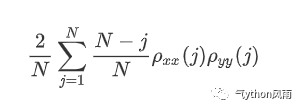一种有效自由度的python实现与双尾t检验测试
一种有效自由度的python实现与双尾t检验测试
用户11172986
发布于 2024-06-20 16:38:10
发布于 2024-06-20 16:38:10
代码可运行
运行总次数:0
代码可运行
版本:python3.7 数据:随机生成的正态分布数组
�eff≈1�+2�∑�=1��−�����(�)���(�

这里 N 是样本大小,ρXX (j) 和 ρYY (j) 分别是两个采样时间序列 X 和 Y 在时间滞后 j 处的自相关。
NAO implicated as a predictor of the surface air temperature multidecadal variability over East Asia
Tiejun Xie, Jianping Li
这个公式是用于估计两个时间序列X和Y之间的有效样本量(Effective Sample Size)或者是有效自由度,并且有以下各项含义: 公式中的每一项都有特定的含义:
第一项

表示基础样本量的倒数,反映了样本大小对估计精度的贡献。 第二项

�∑�=1��−�����(�)
是关于自相关系数的求和部分,其中

是一种加权系数,用于调整每个时间滞后的贡献,\rho_{xx}(j)\rho_{yy}(j) 表示X和Y在时间滞后j处的自相关系数的乘积。 通过估计有效样本量,我们可以更准确地考虑到自相关性的影响,并进行统计推断和假设检验等分析。
函数实现
np.correlate
def compute_equation(N, X, Y):
Neff = 1 / N # 初始化Neff的值为1 / N
ρ_xx = np.correlate(X, X, mode='full')[N-1:] # 计算X的自相关系数
ρ_yy = np.correlate(Y, Y, mode='full')[N-1:] # 计算Y的自相关系数
for j in range(1, N+1):
Neff += 2/N * ((N - j) / N) * ρ_xx[j-1] * ρ_yy[j-1]
return 1 / Neff
# 调用函数并打印结果
N = 100
xx = np.random.normal(0, 1, 100)
yy = np.random.normal(0, 1, 100)
result = compute_equation(N, xx, yy)
print(result)0.006419097817664573sm.tsa.acf
import numpy as np
import statsmodels.api as sm
def compute_equation2(N, X, Y):
Neff = 1 / N # 初始化Neff的值为1 / N
ρ_xx = sm.tsa.acf(X, nlags=N-1) # 计算X的自相关系数
ρ_yy = sm.tsa.acf(Y, nlags=N-1) # 计算Y的自相关系数
for j in range(1, N+1):
Neff += 2/N * ((N - j) / N) * ρ_xx[j-1] * ρ_yy[j-1]
return 1 / Neff
# 调用函数并打印结果
N = 100
xx = np.random.normal(0, 1, 100)
yy = np.random.normal(0, 1, 100)
result = compute_equation2(N, xx, yy)
print(result)33.852749934880265数据测试
import numpy as np
# 输入两组样本数据(假设为sample1和sample2)
sample1 = np.random.normal(0, 1, 100)
sample2 = np.random.normal(0, 1, 100)import scipy.stats as stats
import matplotlib.pyplot as plt
# 执行双尾t检验
statistic, p_value = stats.ttest_ind(sample1, sample2)
# 输出结果
print("T统计量:", statistic)
print("P值:", p_value)
# 计算有效自由度数
N = len(sample1)
df = 1 / compute_equation(N, sample1, sample2)
# 计算t分布的临界值
alpha = 0.90
t_critical = stats.t.ppf(1 - alpha / 2, df)
print('tc',t_critical)T统计量:-1.7797481108940942
P值:0.076650975597045
tc 0.1258061608005306import numpy as np
import scipy.stats as stats
import matplotlib.pyplot as plt
# # 输入两组样本数据(假设为sample1和sample2)
# sample1 = np.random.normal(0, 1, 100)
# sample2 = np.random.normal(0, 1, 100)
# 执行双尾t检验
statistic, p_value = stats.ttest_ind(sample1, sample2)
# 输出结果
print("T统计量:", statistic)
print("P值:", p_value)
# 计算有效自由度数
N2 = len(sample1)
df2 = 1 / compute_equation2(N, sample1, sample2)
# 计算t分布的临界值
alpha = 0.90
t_critical2 = stats.t.ppf(1 - alpha / 2, df2)
print('tc',t_critical2)T统计量:-1.7797481108940942
P值:0.076650975597045
tc 2.591595063118441绘图
numpy计算结果
# 设置图形大小
plt.figure(figsize=(10, 6)) # 设置宽度为10,高度为6
# 绘制折线图
x = np.arange(len(sample1))
plt.plot(x, sample1, label='Sample 1')
plt.plot(x, sample2, label='Sample 2')
plt.xlabel('Index')
plt.ylabel('Value')
plt.title('Line Chart of Samples')
plt.legend(loc='upper left')
# 绘制虚线区域
n1 = len(sample1)
n2 = len(sample2)
fill_x = np.array([min(x), max(x)])
fill_y = t_critical * np.sqrt((np.var(sample1) / n1) + (np.var(sample2) / n2))
plt.fill_between(fill_x, -fill_y, fill_y, color='gray', alpha=0.3)
# 显示图形
plt.show()
statsmodels计算结果
# 设置图形大小
plt.figure(figsize=(10, 6)) # 设置宽度为10,高度为6
# 绘制折线图
x = np.arange(len(sample1))
plt.plot(x, sample1, label='Sample 1')
plt.plot(x, sample2, label='Sample 2')
plt.xlabel('Index')
plt.ylabel('Value')
plt.title('Line Chart of Samples')
plt.legend(loc='upper left')
# 绘制虚线区域
n1 = len(sample1)
n2 = len(sample2)
fill_x = np.array([min(x), max(x)])
fill_y = t_critical2 * np.sqrt((np.var(sample1) / n1) + (np.var(sample2) / n2))
plt.fill_between(fill_x, -fill_y, fill_y, color='gray', alpha=0.3)
# 显示图形
plt.show()
小结
- 画出来和文献不一样,可能数据处理不当或者数据差异导致。
- 随机数组是随机,f需要多试几次,也可自己搓一个符合的数组。
- 同一数组计算对比来说,sm.tsa.acf函数计算结果置信区间更大。
封面生成:ai
/imagine prompt: color photo of a mathematician surrounded by equations and calculations, busy calculating degrees of freedom in a complex system —c 10 —ar 2:3
本文参与 腾讯云自媒体同步曝光计划,分享自微信公众号。
原始发表:2023-11-30,如有侵权请联系 cloudcommunity@tencent.com 删除
评论
登录后参与评论
推荐阅读
目录

